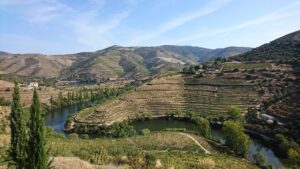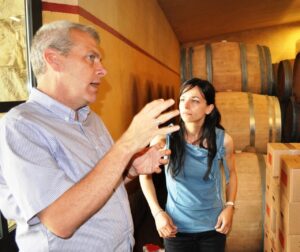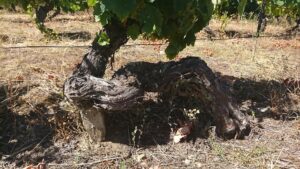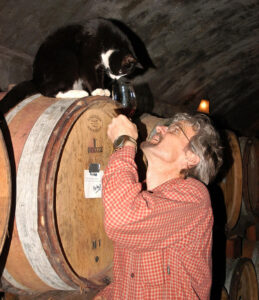AN ATTEMPT TO DEMYSTIFY THE LORE OF OLD VINES
story and photos by Shane McGoey
“Old vines yield fewer grapes, but the grapes they do yield have more concentrated flavors.” This statement is an oft-regurgitated axiom in the world of wine. Again and again we see vine age cited as a determining factor of a given wine’s quality, yet the reasoning behind this theory can at times seem largely speculative and anecdotal.
I wanted different perspectives on the matter so I had this dictum appraised by an oenologist, geologist, three winemakers, and a biochemist. Their responses invited a whole lot more discussion than I’d bargained for, taking the form of, among other things, academic empiricism and meditations on vinification and viticulture that were shaped in part by experience and personality.

“Why in the world would anyone plant anything here?” Scott McLean says he asked himself while maturity sampling the precipitously steep vineyards of the Douro Valley in Portugal. McLean, a winemaker, WSET Diploma holder and most recently the cellar master for Gramercy Cellars in Washington, spent the first half of last harvest with Niepoort Winery in the Douro Valley. While scaling the terraced hillsides, he collected for the lab a smattering of grapes from plants ranging anywhere from 40 to 100 years old. “The amount of effort that went into constructing the terraces and planting the vineyards 80 to 100 years ago is mind-boggling.”
As for the presentation of these vinhas velhas, coming from someone who’s used to traversing the evenly spaced, antiseptic vertical-shoot positioning of the New World: “Anarchy,” McLean uses to describe the lack of trellising, random vine training, grape varieties unseparated by blocks, reds and whites interplanted, cats and dogs living together . . . although venerable with age and rich in history and character. The soil in the Douro is notoriously poor, lacking fertility, and very rocky, which is good for drainage, which is good for grapevines as their root systems web deeper in search of dwindling water, in turn stressing the vines, therefore inducing the plant to produce its choicest fruit . . . or is this yet another wives’ tale?
“We often say that the texture and chemistry of the soil will influence the flavor profile of the wine,” says Dr. Barry Cameron, a Canadian geologist (and volcanologist), as well an Associate Professor who lectures on terroir at UW-Milwaukee. “Usually, the highest quality wines come from vineyards where the vines are water stressed.”
Cameron’s vocation to terroir began on sabbatical in Italy—specifically Sicily—where he traveled to study the 122 BCE Plinian eruption of Mt. Etna, and tasted Nerello Mascalese from the north flank of the volcano. “Kees [van Leeuwen, Professor of Viticulture at Bordeaux Sciences Agro,] emphasizes that limited water supply to the vines will restrict shoot and berry growth, which in turn leads to a desired grape composition in the production of high-quality red wines,” continues Cameron. “Diego Tomasi [of the Conegliano Viticulture and Enology Research Centre] has shown how soil plays a major role in water availability to the vine and affects vine yield, vegetative growth, vine balance, grape composition, and wine sensory profile. Moreover, wines that showed the most interesting characteristics were from root systems that were dense and distributed throughout the soil profile.”

That answers that, then. Or does it? We are talking about the miracle of grape fermentation and the je ne sais quoi of terroir after all. Cameron defines terroir as “the complete physical environment of the grapevine including bedrock geology, soils, climate, slope, and aspect of the terrain that profoundly impacts the character of the wine,” and puts emphasis on vintage and “human terroir.”
“Concentration is a matter of site (terroir), clones of grapes and the particular vintage,” says John Paul, owner and winemaker of Cameron Winery in the Willamette Valley of Oregon. Paul has a background in microbial and plant biochemistry and is also the co-founder of the Deep Roots Coalition. “Terroir is everything about the site that influences what that wine becomes; in essence, the wine has a story which is defined by the terroir. And one of the most basic parts of terroir is precipitation: when it comes, how much there is. Irrigation wipes out that very important signature of terroir.”
And so, this third-rail issue rears its head. The oldest vines in the world (including McLean’s vinhas velhas) are dry-farmed, forcing the roots to burrow into the earth in chase of the water table. Since the 1980s Paul has cultivated Pinot Noir and Chardonnay using Burgundy clones which emigrated to the States in the nineteenth century. The roots of his sustainably-(dry)-farmed vineyards, Clos Electrique and Abbey Ridge, have grown at least 20 feet down into the red Jori soil. “If one truly wants to taste the terroir,” Paul explains, “the vines need to be dry-farmed. Otherwise you have created an artificial situation that has nothing to do with the site.”
When I ask Paul about disease pressure on his Oregon vines, he replies: “Irrigated vines do not live as long as dry-farmed vines because their roots stay relatively shallow [and are more susceptible to disease].”

And on the issue of depriving a grapevine of water in order to coerce better production, Paul says that “Old vines [meaning of course dry-farmed] have deep root systems and canopies that are adapted to the situation (leaves with 50% less stomata than irrigated leaves, fewer leaves per vine and generally waxier). Even in very hot vintages it is rare to see these vines get truly stressed . . . [On the other hand] Irrigation produces a dense leaf canopy whose sole purpose is to produce sugar, lots and lots of it! This then gets transported into the maturing grape clusters, thus when ‘ripe’ the sugar content is much higher.” The net result being Napa wines with ABVs of over 15%.
Paul’s conclusions on the matter are delivered with characteristic (I’ve come to find) staunchness and brio: “Older vines make more compelling wines: wines that have better structure, subtle aromatic characteristics, and definitely longer finishes.”
But what of the other half of the axiom? Does production really diminish with vine age? According to a study performed by Andy Reynolds in the Niagara Peninsula, Cameron disputes this: “Though the vines were not greatly different in age, only about 10 years, older vines had greater yields. Perhaps surprisingly, the must and wine from young vines had more concentrated phenols and anthocyanins compared to old vines.” And based on a more recent Ph.D. dissertation out of Australia, Cameron attributes the increase in production to the wider trunk circumference of older vines, allowing the vine to deliver more nutrients to the berries. “The wine region,” he expounds, “not vine age, seemed to influence grape and wine composition. From a terroir perspective, I was interested to see that tannins and phenolics were differentiated by wine region rather than vine age.”

“Older vines tend to have more short-chain (seed) phenolics at similar ripeness,” states Timothy Donahue, the Director of Winemaking for College Cellars of Walla Walla and an Instructor of Enology at Walla Walla Community College. Donahue has a Master of Science from the University of Adelaide and is a habitual wine demystifier. “This will give older vines a more robust tannin profile and you have to be a little more careful with extraction. This leads to the notion that older-vine wines are more ‘concentrated.'”
Donahue bases this on his 2013 phenolics study that used Cabernet Sauvignon plants spanning 30 Washington vineyards at the same ripeness (26 Brix). “The one thing that really stuck out,” says Donahue, “was that vine age was correlated with increased catechin and epicatechin levels. These compounds are markers for ‘seed’ tannin.” Though these compounds provide a good foundational structure for the wine, they can show as ‘dusty’ and ‘astringent,’ thereby requiring more of a focus on oxygen management during and after fermentation ensuring the wine doesn’t punch you in the face.
Refusing to take the bait of my black and white questions on vine age, Donahue concludes, “Depending on how the wine is vinified and the approach the winegrower takes, any wine can age phenomenally and be concentrated . . . but general practice in the vineyard plays a much greater role than simply age.”
McLean spent the latter half of harvest in Portugal’s Dão region working for a natural producer called Quinta da Boavisa/Joao Tavares de Pina. The winery had rented a vineyard with an average vine age of 50 years which had previously been heavily treated with herbicides; thus, their first task was to cut back the weeds so that they would decompose and replenish the soil with organic matter. McLean also notes that there are olive trees planted among the vines and that this eccentric polyculture farming is something of a Portuguese tradition.
“I think for any winery working with old vines which grape varieties make up the vineyard is sort of beside the point. The vineyard location, vine age and other physical characteristics are more important,” says McLean. The winery is hands-off in the cellar so that the wine can better communicate the vineyard’s past—or share its story. “For me,” McLean concludes, “wines from these old vines are a link to the past. You are able to taste the results of someone’s idea to plant a vineyard a century ago.” McLean plans to one day return to Portugal to make his own wine, where any of the vinhas velhas fruit that isn’t subsumed by the local co-ops is a win for the Rebel Alliance.
Back in the New World, John Paul is also a proponent of letting his vineyards speak for themselves—with the help of his animal laborers. “The one thing about biodynamics that I really feel strongly about is mixing animals into the farming equation,” says Paul. “They turn over vegetable matter and enrich the soil. The chickens grind up and down the vine rows in their ‘chicken tractors’ digging up earth and fertilizing it, and the sheep graze and recycle the organic matter back into the soil.”
To postulate: You don’t need old vines to make great wine, but perhaps a lighter touch in the cellar would behoove winemakers today. I’m not saying be complacent—you still need sulfur, and you still have to top your barrels—but try to strike a balance. After all, it’s winemaking not CRISPR. To further opine: Stop manipulating for color—it’s a fatuous fad; stop using enzymes for a quicker turnaround, you are squandering real potential chasing a buck; stop stripping wine of its sediment—you are neutering its character (and we should be educating the consumers who send back hazy wines at restaurants); reintroduce a balance of alcohol and harmony to the wine . . . and let it age on its own time. The public would eventually come around, providing there is an outlet.
And, so, as for my own conclusion to this quixotic inquisition, regardless of which story the “human terroirist” is trying to tell, the vintner’s or the vineyard’s, wine can still be our connection to the earth—if we let it.
